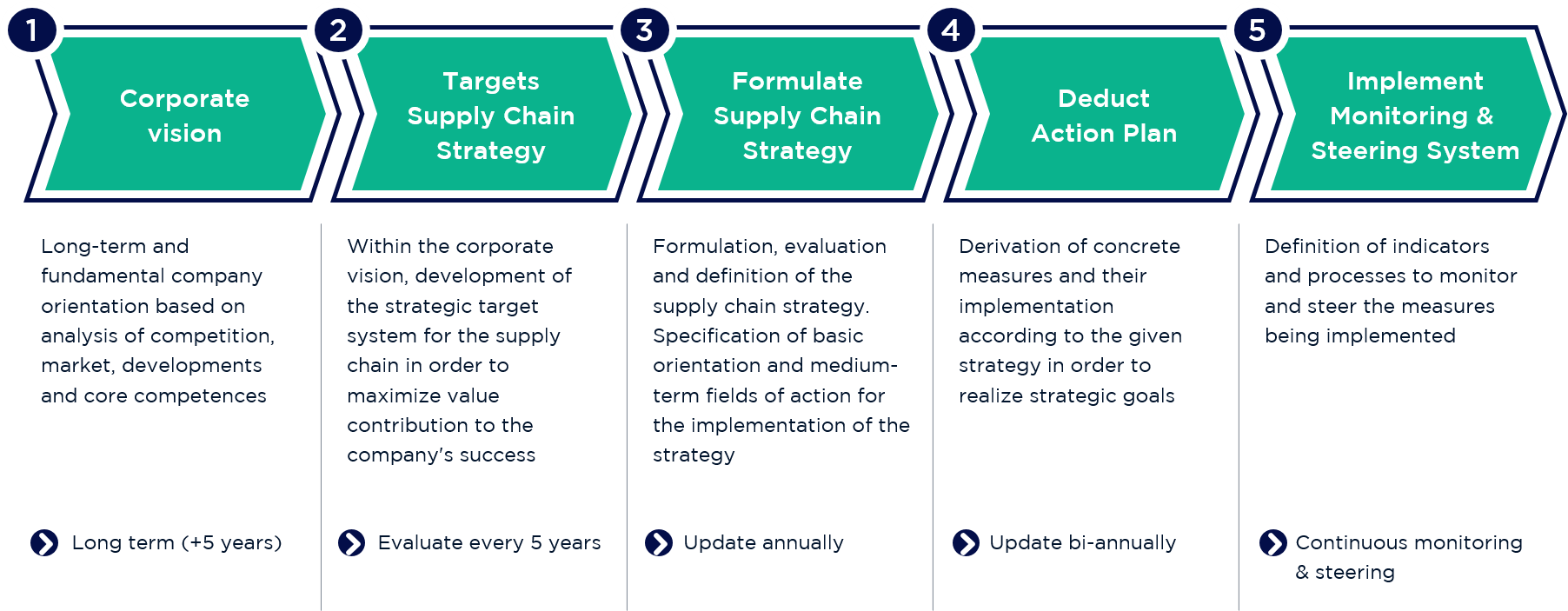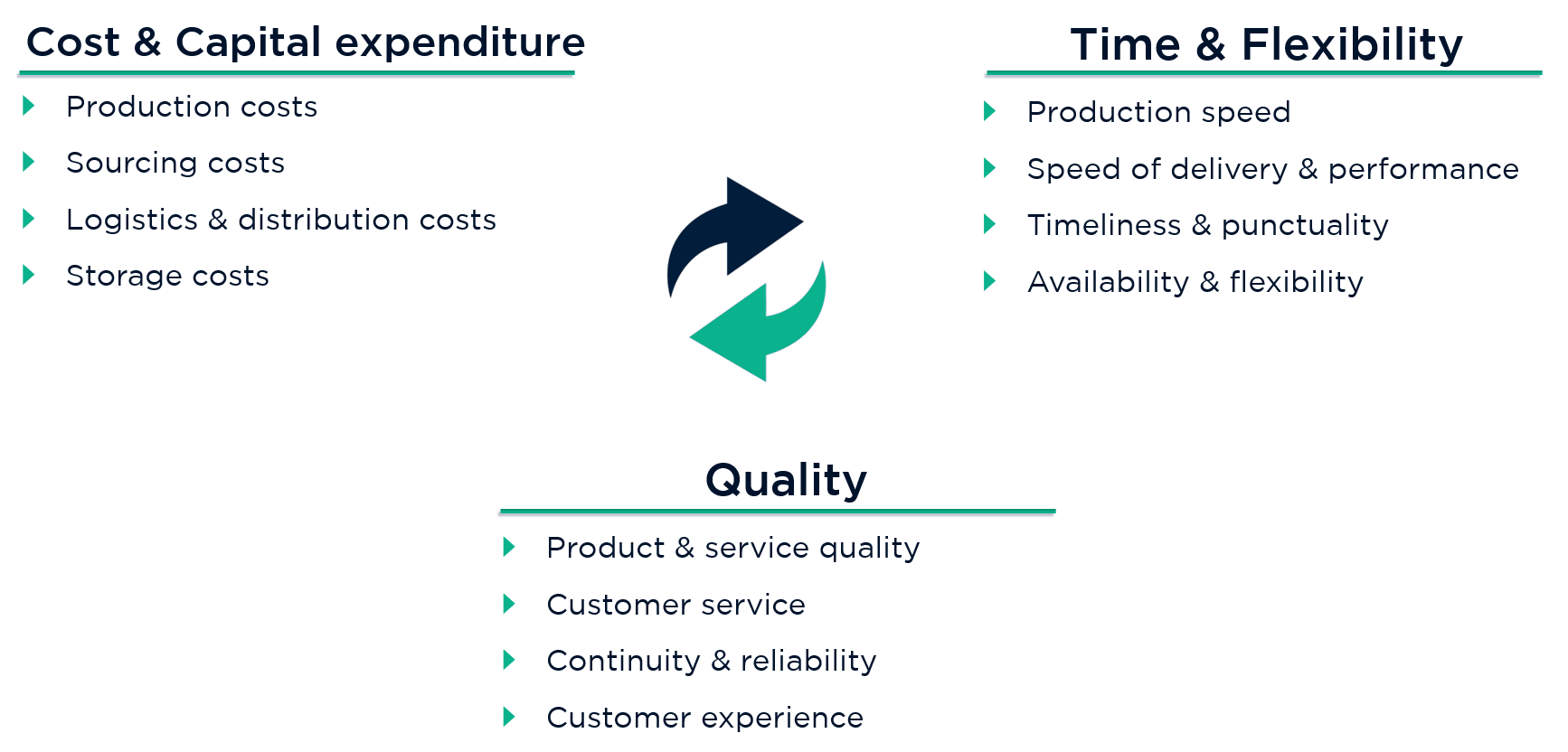- Supply Chain Strategy
- Supply Chain Network Design
- Inventory Management & EOQ
- Route Optimisation
- Distribution Logistics Tendering
- Fulfillment & Warehouse Logistics
- Last Mile Transport Tender
- eSCM & Supply Chain Analytics

Supply Chain Strategy: Development, Implementation and Outlook
The supply chain strategy defines the behavior of a company or a business unit along the value chain. Successful supply chain strategies allow competitive advantages to be continuously assessed and the supply chain to be designed in a targeted manner. An optimised supply chain design makes a decisive contribution to a company's success by ensuring profitability and customer satisfaction, from the creation of products and services to their provision. In the context of the competitive circumstances, the market, and product development, as well as the procurement and sales markets, the supply chain strategy answers questions such as:
- What is the appropriate level of vertical integration and ideal production philosophy?
- Where are the optimal production sites and processes located?
- How should the logistics network be designed?
- How and to what extent are suppliers and partners integrated into the supply chain?

In the following sections, we describe the development and implementation of a supply chain strategy, show how to approach the topic of the supply chain design, and provide an outlook on the added value and future challenges.
Integration of the supply chain strategy into the corporate strategy
Based on a strategic analysis carried out in the strategic planning phase, the management team formulates the corporate goals in order to specify the direction and orientation of the company and ensure its ongoing success.
These strategic goals form the basis of the strategy development phase. In this phase a strategy is developed, evaluated, and put in place in order to achieve the stated objectives.
Strategy development takes place in 3 hierarchies: corporate strategy, business unit strategy, and functional strategy. While being dependent on the corporate strategy, the subordinate strategy levels are also shaping it in the iterative development process.
As one of the central functional strategies, the supply chain strategy has the role of generating competitive advantages within its sphere of influence – the supply chain. In doing so, it coordinates with the adjacent functional areas, such as the product or market strategy, in order to contribute to the optimum overall result for the business unit.
Criteria for the performance assessment and targets within the supply chain strategy
In order to develop the optimal supply chain strategy, it is first necessary to identify and then define the supply chain target performance criteria.
1) For the identification of possible performance criteria, one can be guided by the 2 key dimensions of a supply chain’s value contribution:
- Costs: The most economical production and provision of products and services to the customer possible
- Customer satisfaction: Ensuring customer satisfaction through delivery duration, timings and performance, as well as the quality
From this, 3 groups of performance criteria can be derived. The criteria are partly interdependent, which is why conflicting goals can arise between the criteria. For example, transport by sea freight is in most cases the most cost-effective but results in a significant increase in delivery time. Fast availability, on the other hand, can mean high warehousing costs due to required inventory.
The performance criteria can vary by industry, product type, market segment, distribution channel, or customer group. A joint workshop with the various operational departments along the supply chain is a suitable means to gather a comprehensive list of criteria. A comparison with other known supply chains, such as that of a competitor, can also bring to light further criteria that have been overlooked due to the company's own habits.

2) The next step is to identify and evaluate the most important future requirements for the supply chain and to incorporate them into the defined supply chain target performance criteria.
For this purpose, a strategic analysis of the sources of value creation along the individual supply chain and the overall value proposition for customers is conducted. This allows for the supply chain criteria to be weighted and thus taken into account for the further development of the supply chain strategy.
For example, in the case of luxury goods, the demands of quality and customer service are much more heavily weighted than cost and often delivery speed. In contrast, for many commodity products, cost and availability are the decisive criteria.
Determining the important criteria for developing a supply chain strategy requires in-depth customer, market, and supply chain knowledge. Beyond this, however, the most important aspect is the holistic perspective together with the other functional areas and the assessment of the overall value creation for the customer.
Using these analyses and assessments as a basis, management sets quantitative performance targets for each criterion and thus the targets for developing the supply chain strategy. A typical performance target is the definition of service levels in terms of availability and delivery times or the definition of TCO product cost targets.
Benchmarking of competitors as well as customer surveys are proven means to support the definition of the targets and also to evaluate the desired customer impact. In the next step, the defined criteria are the starting point for the formulation of strategic decisions such as the vertical integration in manufacturing, choice of location, production processes, procurement, and distribution.
Strategy formulation part 1: Production strategy and process flows
With the supply chain performance targets set, the next step is to formulate options for the supply chain's production and process flows, evaluate them, and then put them in place.

In the development of a supply chain strategy, a distinction must be made as to whether the supply chain is to be newly developed on a "greenfield" basis or built on an existing supply chain. Depending on whether fundamental supply chain options are to be addressed, profound, far-reaching decisions must be made first. Therefore, the following production decisions of the supply chain design need to be made first, always in view of the company's own core competencies and its contribution to value creation:
- Centralised or decentralised locations in production, warehousing, and distribution
- Manufacturing depth and vertical integration
- Determination and alignment with manufacturing and supply chain philosophy (push, pull, lean management, Kaban, Six Sigma, etc.)
Based on these supply chain design prerequisites, process options are then developed in the areas of production, order processing, warehousing, logistics networks, and procurement. The options are evaluated and selected with regard to the target criteria set in step 2. At this point the “make or buy” decision for parts of the supply chain is also evaluated.
Production strategy and process operations are among the most profound and often capital-intensive decisions. Today's requirements, rapid change, and increasing competition in the field of value chains increasingly require a high degree of flexibility and specialisation, which is why, in addition to questions of outsourcing or contracting out, the integration of suppliers and customers into the supply chain is becoming more and more important in order to secure competitive advantages.
Strategy formulation part 2: Degree of integration - customers, suppliers, systems
The final step in formulating the supply chain strategy is to determine the degree of integration with customers and suppliers. Decisive factors with regard to supplier integration are a lack of know-how, synergy effects on the part of the suppliers, flexibility, or increased capital commitment. Supplier integration is often found, for example, in the retail business, where highly specialised 3PL service providers often take over the warehousing, shipping, and logistics services.

Customer integration is often found in the chemical or pharmaceutical industry, where manufacturers install small production or laboratory analysis systems directly at the customer's site in order to realise competitive advantages through response times.
When integrating suppliers and customers into the supply chain, risks from dependencies, loss of intellectual capital, and loss of control and quality must be considered and monitored.
In order to manage risks and to control the supply chain efficiently with regard to the achievement of objectives and to adjust it if necessary, many companies are digitalising the entire supply chain. Integrated ERP systems as well as transport management systems allow companies to manage the supply chain and its resources cost-efficiently while improving customer service. In order to make the right decisions quickly, dynamic dashboards with up-to-date data are recommended. (Click here for an example of a cost management dashboard).
Beyond the overall control tools, there are many ways to better utilise the resources along the supply chain processes in today's digital world: Route optimisation software, scheduling software, procurement and transportation resource allocation software, production planning and control software, track and trace solutions, etc. The offer is very broad and diverse, which is why the selection of a software solution that fits you and your goals and an expeditious implementation are critical for success. (Learn more about our logistics module Digital Logistics Management & Reporting)
In addition to the strategic decisions for the integration of suppliers and customers into your own supply chain, system integration is becoming increasingly important in the fight for competitive advantages and thus the supply chain strategy.
Implementation of the supply chain strategy
The formulated supply chain strategy remains ineffective in itself if it is not properly implemented. To this end, concrete action points must be initiated to meet the strategy's specifications. In order to make this process as efficient as possible, the derived measures and actions must be sequenced in a plan in a meaningful way. With regard to the achievement of the strategic target performance criteria, suitable resources, appropriately shared responsibilities, and transformation processes are just as critical to success as the appropriate measurement and control systems.
Successful implementation is often characterised by the correct prioritisation of initiatives and resource allocation. The areas affected by the supply chain strategy are very different in terms of their requirements, knowledge, and challenges, and are therefore separate areas of expertise in their own right. To that end, experts for the respective sub-area must always be involved for successful implementation.
It always requires the interplay of strategic and operational supply chain management resources, appropriate project skills, and expertise. From IT system integrations, to the realignment of the global supply chain network, or topics that intervene in production and warehouse processes with different objectives, the range of experience and skills required is enormous. Technical expertise, individually tailored solutions, as well as sustainable implementation and change management are key to success.
Outlook and recommendation on the supply chain strategy
In today's environment, companies will lose market share if they realise the importance of a competitive supply chain strategy too late. Innovation, the required flexibility to deal with the constantly emerging opportunities, and the risks of normal business activities are creating new avenues for supply chain design. This means opportunity for some and the risk of losing serious ground to the competition for others. A recent trend is to increase cost and process efficiency and flexibility by integrating specialised partners and digital processes. However, despite all the advantages, the resulting risks must not be ignored. Without transparent risk management and the appropriate design, unsuitable IT systems, supplier agreements, procurement activities, production, or warehousing strategies can even reduce the value contribution of the supply chain instead of improving it.
Beyond these developments, with our already globalised and interconnected world, we are now being confronted with the influence and impact of climate change and climate protection. In the future, supply chains will have to answer the question of sustainability and climate friendliness differently in order to continue to compete in the marketplace.
In summary, companies of the future will need to continue to constantly adapt and reconfigure their supply chains in response to new opportunities and threats to their competitive position.
OCM offers comprehensive support in designing your customised supply chain strategy as well as its implementation through our comprehensive Supply Chain & Logistics product offering. Check out our OCM Strategic Impulse Series which presents selected insights that contextualise current geopolitical, technological, and economic developments with a specific focus on Procurement, Logistics, and Supply Chain Management.
We combine our proven approach to supply chain strategy development with the areas of supply chain operations and digitalisation. We would be happy to present our approach and modules to you and discuss solutions based on your challenges.

Our project modules at a glance:
Logistics optimisation & Supply Chain Consulting modules
Logistics & SCM Opportunity Assessment
- Benchmarking & maturity testing
- Identification of opportunities & action plan
Transport Partner Management
- Transport partner strategy & professionalisation
- Securing resources and resource training design
Transport Tender
- Competition, effective transport tendering, fact-based negotiation
- Transport cost reduction
Freight & Logistics Tender
- Competitive pricing, quality, and performance assurance
- Individual weight-distance matrix
Warehouse Optimisation
- Efficient warehouse logistics & layout
- Optimised processes & working capital
Logistics Cooperation
- Optimising logistics through synergies
- Finding a fair and stable collaboration model
Route Optimisation
- Distance and route reduction
- Reduce resource & logistics costs
Supply Chain Network Optimisation
- Optimise delivery times, service levels, & processes
- Reduce working capital
Inventory & Order Management
- Optimal order quantity & stock on hand
- Optimise working capital
Fleet Optimisation
- Fleet concept tailored to requirements
- Cost optimisation
Supply Chain & Logistics Strategy
- Sustainable maximum value contribution of the supply chain
- Clear objectives, concrete measures
Digital Logistics Management & Reporting
- Information advantages in speed, scope, & significance
- Efficiency through automation, data integration & process simplification
Interim Supply Chain & Logistics Manager
- Rapid response: candidates within 48h
- Matching of requirements and assessment of suitability using logistics experts
- From dispatcher to logistics manager
Short-term staff shortage? Unexpected need for action?
Learn more